Reflective Analysis of Teaching Practice in Higher Education: ICDD7011
VerifiedAdded on 2022/11/07
|10
|2712
|270
Report
AI Summary
This report presents a comprehensive reflective analysis of a student's teaching practice within the PGCHEP program, specifically focusing on the ICDD7011 module. The analysis begins with the student's initial teaching vision and progresses through their experiences with various teaching methods, curriculum development, and student engagement strategies. The report details the impact of the PGCHEP course on the student's understanding of educational theories and their practical application in the classroom. It examines the use of reflective teaching practices, constructive alignment, and different learning styles, including scaffolding learning theories. The student reflects on specific modules, such as business management, human resource management, and personal tutoring, and discusses the implementation of innovative teaching methods like flipped classrooms and technology-based learning. Furthermore, the report addresses curriculum development, threshold concepts, diversity and inclusivity, and the importance of individual learning plans and SMART targets. The student also explores the significance of multi-sensory approaches, conceptualizing information styles, and the application of various learning theories, such as Vygotsky's theory. The report concludes with a discussion of the student's personal growth and future professional development plans. The student has provided a detailed description of the features of the change to practice, demonstrating how this has been informed by educational theory and suggest an evaluation methodology, including addressing issues of sustainability. The student has reflected on their experience of learning on the module and considered the impact on their personal practice, relating this to future plans for professional development. The student has provided evidence to fulfil the Fellow (Descriptor 2) requirements of the UKPSF.
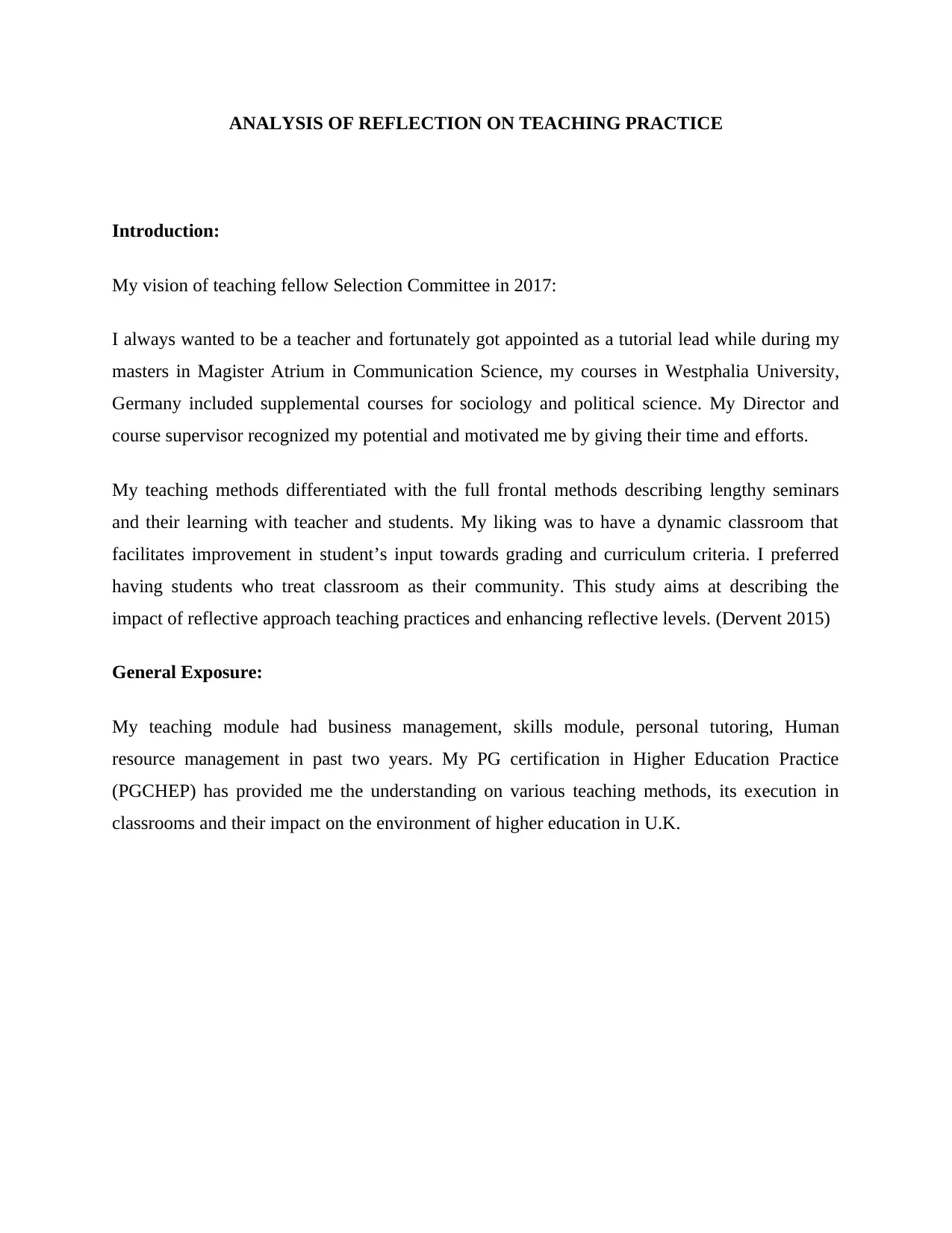
ANALYSIS OF REFLECTION ON TEACHING PRACTICE
Introduction:
My vision of teaching fellow Selection Committee in 2017:
I always wanted to be a teacher and fortunately got appointed as a tutorial lead while during my
masters in Magister Atrium in Communication Science, my courses in Westphalia University,
Germany included supplemental courses for sociology and political science. My Director and
course supervisor recognized my potential and motivated me by giving their time and efforts.
My teaching methods differentiated with the full frontal methods describing lengthy seminars
and their learning with teacher and students. My liking was to have a dynamic classroom that
facilitates improvement in student’s input towards grading and curriculum criteria. I preferred
having students who treat classroom as their community. This study aims at describing the
impact of reflective approach teaching practices and enhancing reflective levels. (Dervent 2015)
General Exposure:
My teaching module had business management, skills module, personal tutoring, Human
resource management in past two years. My PG certification in Higher Education Practice
(PGCHEP) has provided me the understanding on various teaching methods, its execution in
classrooms and their impact on the environment of higher education in U.K.
Introduction:
My vision of teaching fellow Selection Committee in 2017:
I always wanted to be a teacher and fortunately got appointed as a tutorial lead while during my
masters in Magister Atrium in Communication Science, my courses in Westphalia University,
Germany included supplemental courses for sociology and political science. My Director and
course supervisor recognized my potential and motivated me by giving their time and efforts.
My teaching methods differentiated with the full frontal methods describing lengthy seminars
and their learning with teacher and students. My liking was to have a dynamic classroom that
facilitates improvement in student’s input towards grading and curriculum criteria. I preferred
having students who treat classroom as their community. This study aims at describing the
impact of reflective approach teaching practices and enhancing reflective levels. (Dervent 2015)
General Exposure:
My teaching module had business management, skills module, personal tutoring, Human
resource management in past two years. My PG certification in Higher Education Practice
(PGCHEP) has provided me the understanding on various teaching methods, its execution in
classrooms and their impact on the environment of higher education in U.K.
Paraphrase This Document
Need a fresh take? Get an instant paraphrase of this document with our AI Paraphraser
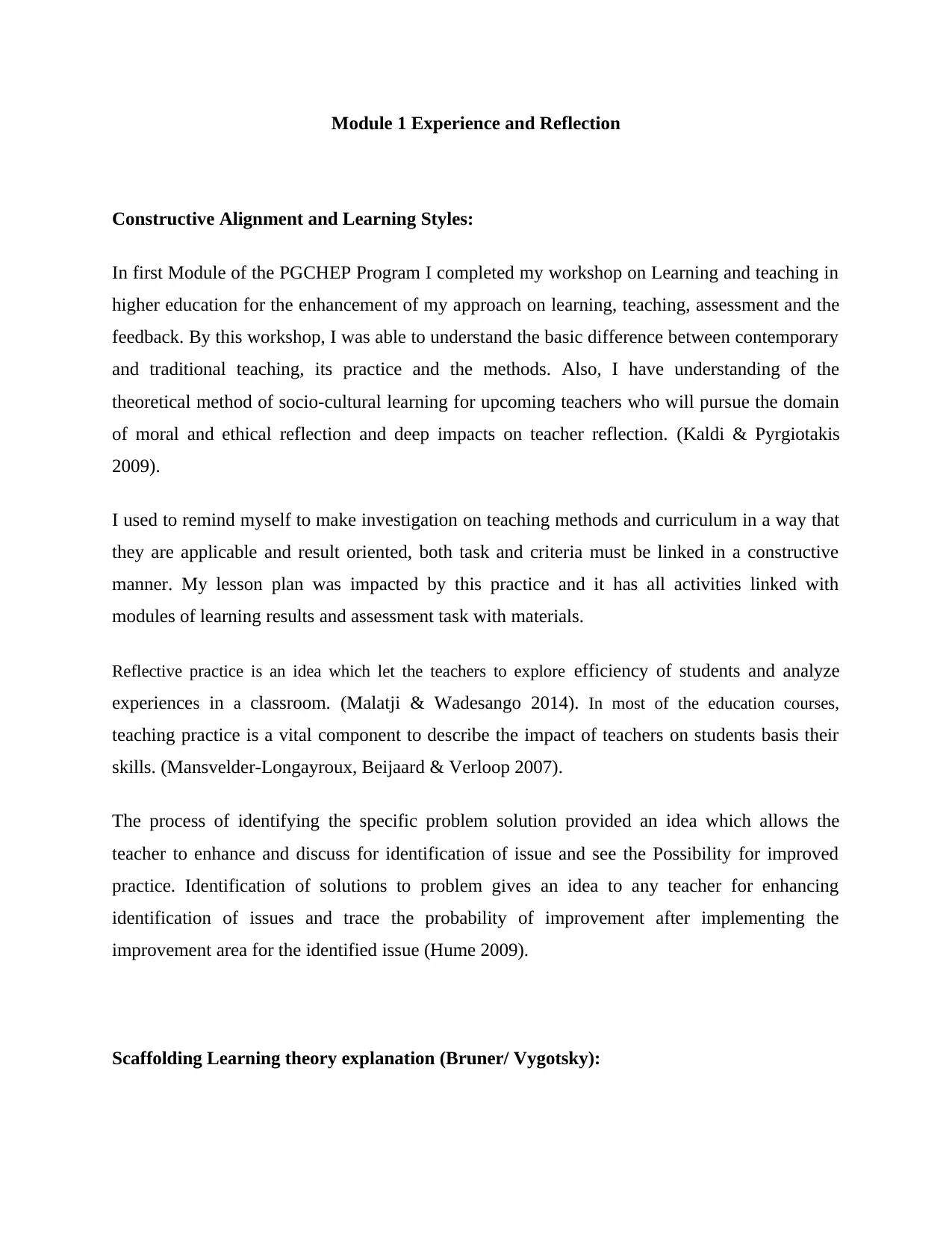
Module 1 Experience and Reflection
Constructive Alignment and Learning Styles:
In first Module of the PGCHEP Program I completed my workshop on Learning and teaching in
higher education for the enhancement of my approach on learning, teaching, assessment and the
feedback. By this workshop, I was able to understand the basic difference between contemporary
and traditional teaching, its practice and the methods. Also, I have understanding of the
theoretical method of socio-cultural learning for upcoming teachers who will pursue the domain
of moral and ethical reflection and deep impacts on teacher reflection. (Kaldi & Pyrgiotakis
2009).
I used to remind myself to make investigation on teaching methods and curriculum in a way that
they are applicable and result oriented, both task and criteria must be linked in a constructive
manner. My lesson plan was impacted by this practice and it has all activities linked with
modules of learning results and assessment task with materials.
Reflective practice is an idea which let the teachers to explore efficiency of students and analyze
experiences in a classroom. (Malatji & Wadesango 2014). In most of the education courses,
teaching practice is a vital component to describe the impact of teachers on students basis their
skills. (Mansvelder-Longayroux, Beijaard & Verloop 2007).
The process of identifying the specific problem solution provided an idea which allows the
teacher to enhance and discuss for identification of issue and see the Possibility for improved
practice. Identification of solutions to problem gives an idea to any teacher for enhancing
identification of issues and trace the probability of improvement after implementing the
improvement area for the identified issue (Hume 2009).
Scaffolding Learning theory explanation (Bruner/ Vygotsky):
Constructive Alignment and Learning Styles:
In first Module of the PGCHEP Program I completed my workshop on Learning and teaching in
higher education for the enhancement of my approach on learning, teaching, assessment and the
feedback. By this workshop, I was able to understand the basic difference between contemporary
and traditional teaching, its practice and the methods. Also, I have understanding of the
theoretical method of socio-cultural learning for upcoming teachers who will pursue the domain
of moral and ethical reflection and deep impacts on teacher reflection. (Kaldi & Pyrgiotakis
2009).
I used to remind myself to make investigation on teaching methods and curriculum in a way that
they are applicable and result oriented, both task and criteria must be linked in a constructive
manner. My lesson plan was impacted by this practice and it has all activities linked with
modules of learning results and assessment task with materials.
Reflective practice is an idea which let the teachers to explore efficiency of students and analyze
experiences in a classroom. (Malatji & Wadesango 2014). In most of the education courses,
teaching practice is a vital component to describe the impact of teachers on students basis their
skills. (Mansvelder-Longayroux, Beijaard & Verloop 2007).
The process of identifying the specific problem solution provided an idea which allows the
teacher to enhance and discuss for identification of issue and see the Possibility for improved
practice. Identification of solutions to problem gives an idea to any teacher for enhancing
identification of issues and trace the probability of improvement after implementing the
improvement area for the identified issue (Hume 2009).
Scaffolding Learning theory explanation (Bruner/ Vygotsky):
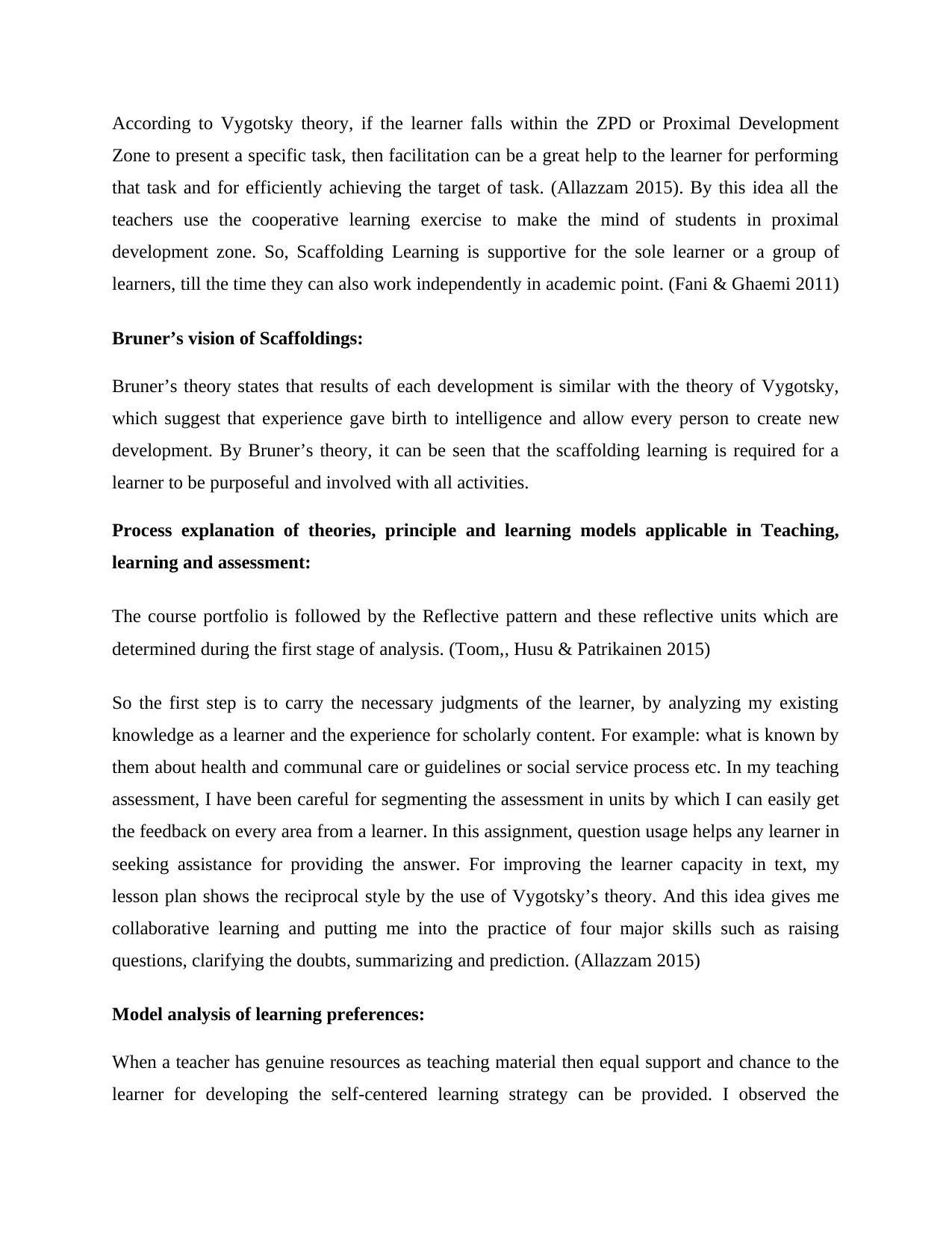
According to Vygotsky theory, if the learner falls within the ZPD or Proximal Development
Zone to present a specific task, then facilitation can be a great help to the learner for performing
that task and for efficiently achieving the target of task. (Allazzam 2015). By this idea all the
teachers use the cooperative learning exercise to make the mind of students in proximal
development zone. So, Scaffolding Learning is supportive for the sole learner or a group of
learners, till the time they can also work independently in academic point. (Fani & Ghaemi 2011)
Bruner’s vision of Scaffoldings:
Bruner’s theory states that results of each development is similar with the theory of Vygotsky,
which suggest that experience gave birth to intelligence and allow every person to create new
development. By Bruner’s theory, it can be seen that the scaffolding learning is required for a
learner to be purposeful and involved with all activities.
Process explanation of theories, principle and learning models applicable in Teaching,
learning and assessment:
The course portfolio is followed by the Reflective pattern and these reflective units which are
determined during the first stage of analysis. (Toom,, Husu & Patrikainen 2015)
So the first step is to carry the necessary judgments of the learner, by analyzing my existing
knowledge as a learner and the experience for scholarly content. For example: what is known by
them about health and communal care or guidelines or social service process etc. In my teaching
assessment, I have been careful for segmenting the assessment in units by which I can easily get
the feedback on every area from a learner. In this assignment, question usage helps any learner in
seeking assistance for providing the answer. For improving the learner capacity in text, my
lesson plan shows the reciprocal style by the use of Vygotsky’s theory. And this idea gives me
collaborative learning and putting me into the practice of four major skills such as raising
questions, clarifying the doubts, summarizing and prediction. (Allazzam 2015)
Model analysis of learning preferences:
When a teacher has genuine resources as teaching material then equal support and chance to the
learner for developing the self-centered learning strategy can be provided. I observed the
Zone to present a specific task, then facilitation can be a great help to the learner for performing
that task and for efficiently achieving the target of task. (Allazzam 2015). By this idea all the
teachers use the cooperative learning exercise to make the mind of students in proximal
development zone. So, Scaffolding Learning is supportive for the sole learner or a group of
learners, till the time they can also work independently in academic point. (Fani & Ghaemi 2011)
Bruner’s vision of Scaffoldings:
Bruner’s theory states that results of each development is similar with the theory of Vygotsky,
which suggest that experience gave birth to intelligence and allow every person to create new
development. By Bruner’s theory, it can be seen that the scaffolding learning is required for a
learner to be purposeful and involved with all activities.
Process explanation of theories, principle and learning models applicable in Teaching,
learning and assessment:
The course portfolio is followed by the Reflective pattern and these reflective units which are
determined during the first stage of analysis. (Toom,, Husu & Patrikainen 2015)
So the first step is to carry the necessary judgments of the learner, by analyzing my existing
knowledge as a learner and the experience for scholarly content. For example: what is known by
them about health and communal care or guidelines or social service process etc. In my teaching
assessment, I have been careful for segmenting the assessment in units by which I can easily get
the feedback on every area from a learner. In this assignment, question usage helps any learner in
seeking assistance for providing the answer. For improving the learner capacity in text, my
lesson plan shows the reciprocal style by the use of Vygotsky’s theory. And this idea gives me
collaborative learning and putting me into the practice of four major skills such as raising
questions, clarifying the doubts, summarizing and prediction. (Allazzam 2015)
Model analysis of learning preferences:
When a teacher has genuine resources as teaching material then equal support and chance to the
learner for developing the self-centered learning strategy can be provided. I observed the
⊘ This is a preview!⊘
Do you want full access?
Subscribe today to unlock all pages.

Trusted by 1+ million students worldwide
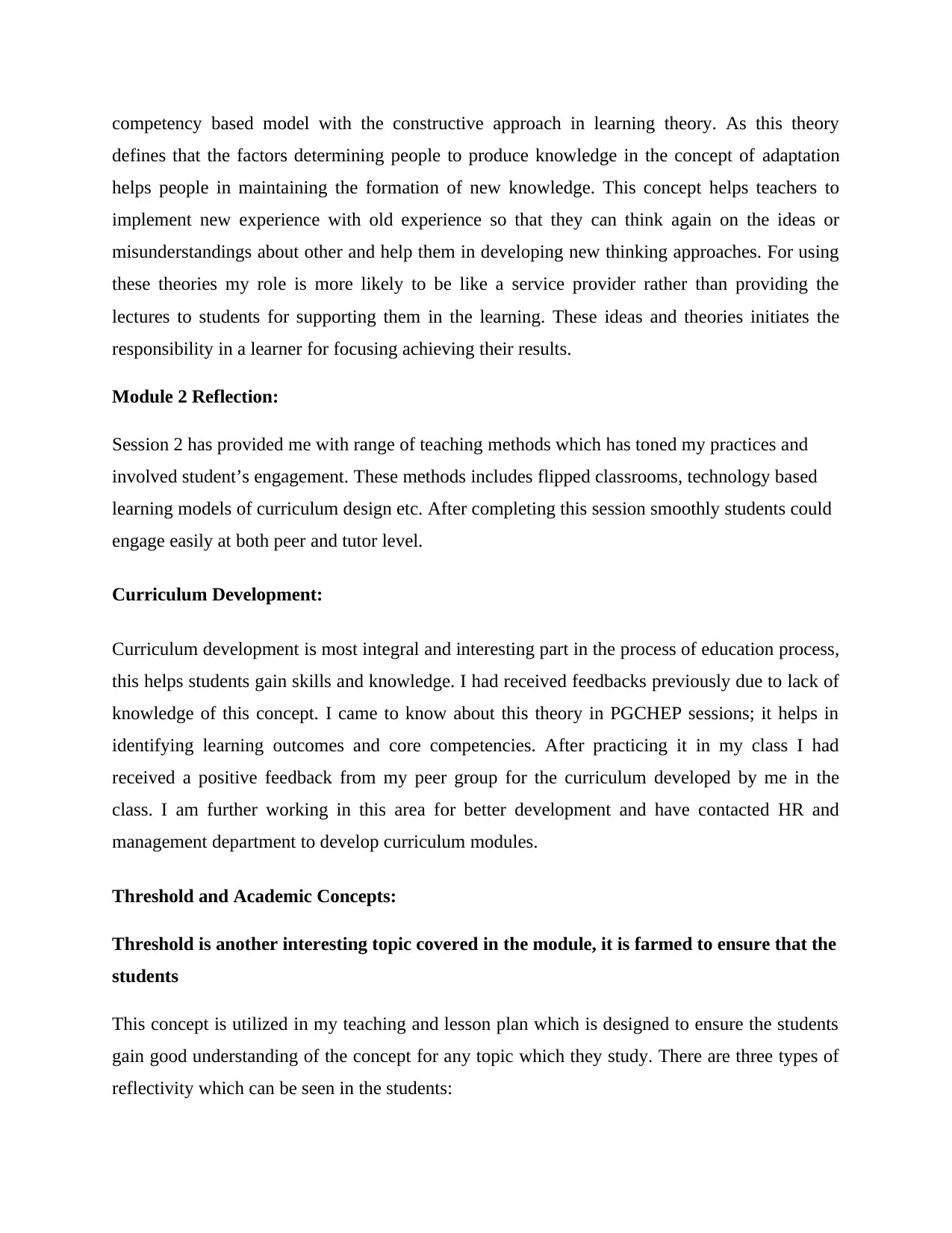
competency based model with the constructive approach in learning theory. As this theory
defines that the factors determining people to produce knowledge in the concept of adaptation
helps people in maintaining the formation of new knowledge. This concept helps teachers to
implement new experience with old experience so that they can think again on the ideas or
misunderstandings about other and help them in developing new thinking approaches. For using
these theories my role is more likely to be like a service provider rather than providing the
lectures to students for supporting them in the learning. These ideas and theories initiates the
responsibility in a learner for focusing achieving their results.
Module 2 Reflection:
Session 2 has provided me with range of teaching methods which has toned my practices and
involved student’s engagement. These methods includes flipped classrooms, technology based
learning models of curriculum design etc. After completing this session smoothly students could
engage easily at both peer and tutor level.
Curriculum Development:
Curriculum development is most integral and interesting part in the process of education process,
this helps students gain skills and knowledge. I had received feedbacks previously due to lack of
knowledge of this concept. I came to know about this theory in PGCHEP sessions; it helps in
identifying learning outcomes and core competencies. After practicing it in my class I had
received a positive feedback from my peer group for the curriculum developed by me in the
class. I am further working in this area for better development and have contacted HR and
management department to develop curriculum modules.
Threshold and Academic Concepts:
Threshold is another interesting topic covered in the module, it is farmed to ensure that the
students
This concept is utilized in my teaching and lesson plan which is designed to ensure the students
gain good understanding of the concept for any topic which they study. There are three types of
reflectivity which can be seen in the students:
defines that the factors determining people to produce knowledge in the concept of adaptation
helps people in maintaining the formation of new knowledge. This concept helps teachers to
implement new experience with old experience so that they can think again on the ideas or
misunderstandings about other and help them in developing new thinking approaches. For using
these theories my role is more likely to be like a service provider rather than providing the
lectures to students for supporting them in the learning. These ideas and theories initiates the
responsibility in a learner for focusing achieving their results.
Module 2 Reflection:
Session 2 has provided me with range of teaching methods which has toned my practices and
involved student’s engagement. These methods includes flipped classrooms, technology based
learning models of curriculum design etc. After completing this session smoothly students could
engage easily at both peer and tutor level.
Curriculum Development:
Curriculum development is most integral and interesting part in the process of education process,
this helps students gain skills and knowledge. I had received feedbacks previously due to lack of
knowledge of this concept. I came to know about this theory in PGCHEP sessions; it helps in
identifying learning outcomes and core competencies. After practicing it in my class I had
received a positive feedback from my peer group for the curriculum developed by me in the
class. I am further working in this area for better development and have contacted HR and
management department to develop curriculum modules.
Threshold and Academic Concepts:
Threshold is another interesting topic covered in the module, it is farmed to ensure that the
students
This concept is utilized in my teaching and lesson plan which is designed to ensure the students
gain good understanding of the concept for any topic which they study. There are three types of
reflectivity which can be seen in the students:
Paraphrase This Document
Need a fresh take? Get an instant paraphrase of this document with our AI Paraphraser

1. Technical Rationality:
It contains the generalization of teaching and learning, which is concerned about teaching in
classrooms but not in any specific incident.
2. Practical Rationality:
It contains the reflection about the teaching and learning caused by the classroom experience.
3. Critical Rationality:
It includes many tasks reflection at a particular moment by covering the incident and other
teaching context. (Nurfaidah, Lengkanawati & Sukyadi 2017).
Diversity and Inclusivity:
Dealing with diversity in classroom
Class discussion was about open, blind spot, unknown self and hidden concepts of johari
window. The students were focused on the open self for the purpose of team work and
improvement in emotional intelligence. That discussion moved to the direction of hidden aspect
and students were given the various examples of it. I took a question with myself if I need to
extend my knowledge for this discussion. And yes, I realized in practical terms. As the society is
not only multicultural and multiracial but also it is a diverse society with a main difference of
sexual orientation and religion. I learned that there should be no discrimination on any level for
the students in the class.
Explanation of a learner’s preference identification includes teaching, learning and
assessment:
Individual Plan of Learning :
It is a framework for determining the strength and weakness of learner in academic year, which
is presented by a teacher or any institutional organization. ILP is also used for the determination
of resources to complete the learning results.
Principles of guidance in ILP development:
It contains the generalization of teaching and learning, which is concerned about teaching in
classrooms but not in any specific incident.
2. Practical Rationality:
It contains the reflection about the teaching and learning caused by the classroom experience.
3. Critical Rationality:
It includes many tasks reflection at a particular moment by covering the incident and other
teaching context. (Nurfaidah, Lengkanawati & Sukyadi 2017).
Diversity and Inclusivity:
Dealing with diversity in classroom
Class discussion was about open, blind spot, unknown self and hidden concepts of johari
window. The students were focused on the open self for the purpose of team work and
improvement in emotional intelligence. That discussion moved to the direction of hidden aspect
and students were given the various examples of it. I took a question with myself if I need to
extend my knowledge for this discussion. And yes, I realized in practical terms. As the society is
not only multicultural and multiracial but also it is a diverse society with a main difference of
sexual orientation and religion. I learned that there should be no discrimination on any level for
the students in the class.
Explanation of a learner’s preference identification includes teaching, learning and
assessment:
Individual Plan of Learning :
It is a framework for determining the strength and weakness of learner in academic year, which
is presented by a teacher or any institutional organization. ILP is also used for the determination
of resources to complete the learning results.
Principles of guidance in ILP development:
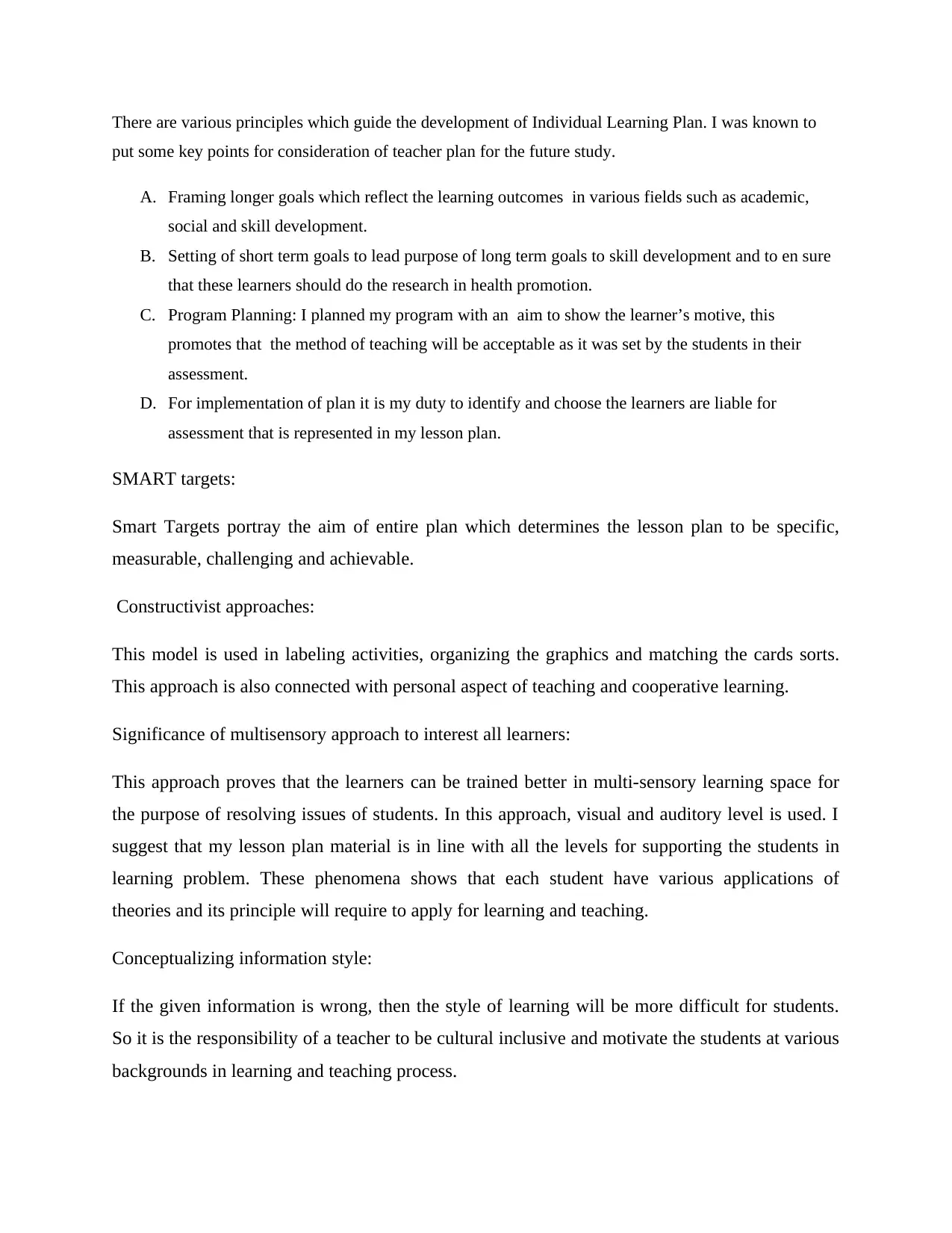
There are various principles which guide the development of Individual Learning Plan. I was known to
put some key points for consideration of teacher plan for the future study.
A. Framing longer goals which reflect the learning outcomes in various fields such as academic,
social and skill development.
B. Setting of short term goals to lead purpose of long term goals to skill development and to en sure
that these learners should do the research in health promotion.
C. Program Planning: I planned my program with an aim to show the learner’s motive, this
promotes that the method of teaching will be acceptable as it was set by the students in their
assessment.
D. For implementation of plan it is my duty to identify and choose the learners are liable for
assessment that is represented in my lesson plan.
SMART targets:
Smart Targets portray the aim of entire plan which determines the lesson plan to be specific,
measurable, challenging and achievable.
Constructivist approaches:
This model is used in labeling activities, organizing the graphics and matching the cards sorts.
This approach is also connected with personal aspect of teaching and cooperative learning.
Significance of multisensory approach to interest all learners:
This approach proves that the learners can be trained better in multi-sensory learning space for
the purpose of resolving issues of students. In this approach, visual and auditory level is used. I
suggest that my lesson plan material is in line with all the levels for supporting the students in
learning problem. These phenomena shows that each student have various applications of
theories and its principle will require to apply for learning and teaching.
Conceptualizing information style:
If the given information is wrong, then the style of learning will be more difficult for students.
So it is the responsibility of a teacher to be cultural inclusive and motivate the students at various
backgrounds in learning and teaching process.
put some key points for consideration of teacher plan for the future study.
A. Framing longer goals which reflect the learning outcomes in various fields such as academic,
social and skill development.
B. Setting of short term goals to lead purpose of long term goals to skill development and to en sure
that these learners should do the research in health promotion.
C. Program Planning: I planned my program with an aim to show the learner’s motive, this
promotes that the method of teaching will be acceptable as it was set by the students in their
assessment.
D. For implementation of plan it is my duty to identify and choose the learners are liable for
assessment that is represented in my lesson plan.
SMART targets:
Smart Targets portray the aim of entire plan which determines the lesson plan to be specific,
measurable, challenging and achievable.
Constructivist approaches:
This model is used in labeling activities, organizing the graphics and matching the cards sorts.
This approach is also connected with personal aspect of teaching and cooperative learning.
Significance of multisensory approach to interest all learners:
This approach proves that the learners can be trained better in multi-sensory learning space for
the purpose of resolving issues of students. In this approach, visual and auditory level is used. I
suggest that my lesson plan material is in line with all the levels for supporting the students in
learning problem. These phenomena shows that each student have various applications of
theories and its principle will require to apply for learning and teaching.
Conceptualizing information style:
If the given information is wrong, then the style of learning will be more difficult for students.
So it is the responsibility of a teacher to be cultural inclusive and motivate the students at various
backgrounds in learning and teaching process.
⊘ This is a preview!⊘
Do you want full access?
Subscribe today to unlock all pages.

Trusted by 1+ million students worldwide
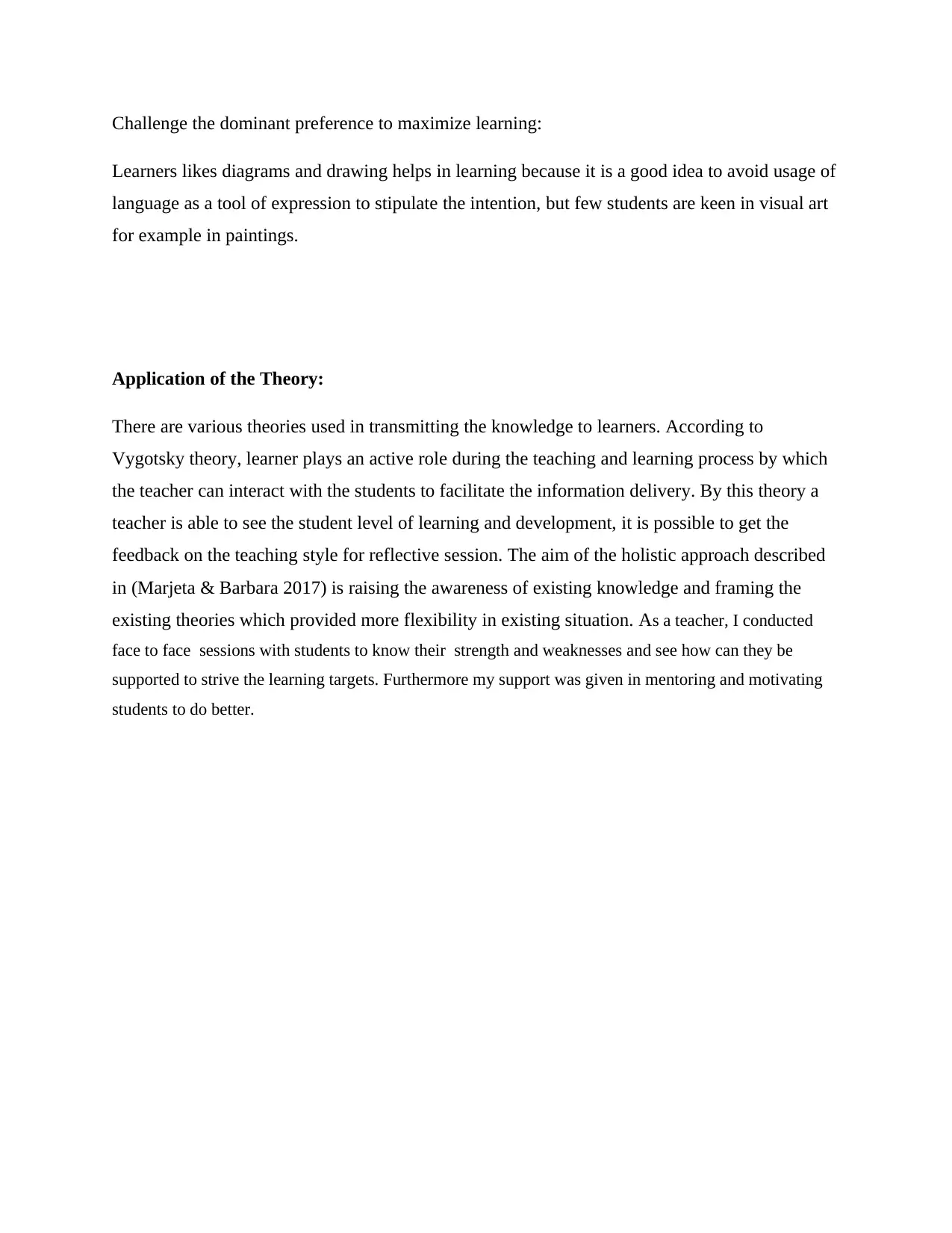
Challenge the dominant preference to maximize learning:
Learners likes diagrams and drawing helps in learning because it is a good idea to avoid usage of
language as a tool of expression to stipulate the intention, but few students are keen in visual art
for example in paintings.
Application of the Theory:
There are various theories used in transmitting the knowledge to learners. According to
Vygotsky theory, learner plays an active role during the teaching and learning process by which
the teacher can interact with the students to facilitate the information delivery. By this theory a
teacher is able to see the student level of learning and development, it is possible to get the
feedback on the teaching style for reflective session. The aim of the holistic approach described
in (Marjeta & Barbara 2017) is raising the awareness of existing knowledge and framing the
existing theories which provided more flexibility in existing situation. As a teacher, I conducted
face to face sessions with students to know their strength and weaknesses and see how can they be
supported to strive the learning targets. Furthermore my support was given in mentoring and motivating
students to do better.
Learners likes diagrams and drawing helps in learning because it is a good idea to avoid usage of
language as a tool of expression to stipulate the intention, but few students are keen in visual art
for example in paintings.
Application of the Theory:
There are various theories used in transmitting the knowledge to learners. According to
Vygotsky theory, learner plays an active role during the teaching and learning process by which
the teacher can interact with the students to facilitate the information delivery. By this theory a
teacher is able to see the student level of learning and development, it is possible to get the
feedback on the teaching style for reflective session. The aim of the holistic approach described
in (Marjeta & Barbara 2017) is raising the awareness of existing knowledge and framing the
existing theories which provided more flexibility in existing situation. As a teacher, I conducted
face to face sessions with students to know their strength and weaknesses and see how can they be
supported to strive the learning targets. Furthermore my support was given in mentoring and motivating
students to do better.
Paraphrase This Document
Need a fresh take? Get an instant paraphrase of this document with our AI Paraphraser
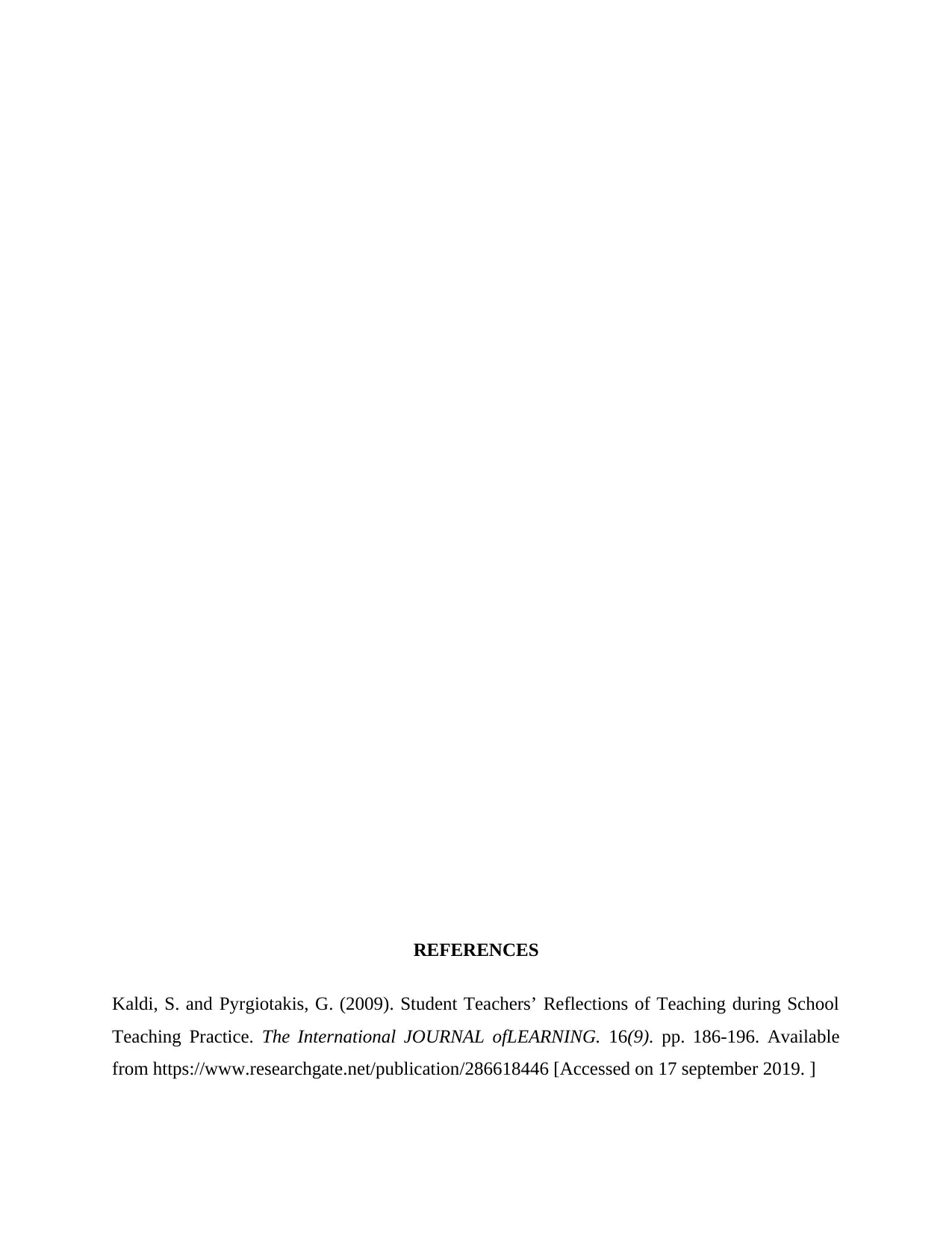
REFERENCES
Kaldi, S. and Pyrgiotakis, G. (2009). Student Teachers’ Reflections of Teaching during School
Teaching Practice. The International JOURNAL ofLEARNING. 16(9). pp. 186-196. Available
from https://www.researchgate.net/publication/286618446 [Accessed on 17 september 2019. ]
Kaldi, S. and Pyrgiotakis, G. (2009). Student Teachers’ Reflections of Teaching during School
Teaching Practice. The International JOURNAL ofLEARNING. 16(9). pp. 186-196. Available
from https://www.researchgate.net/publication/286618446 [Accessed on 17 september 2019. ]
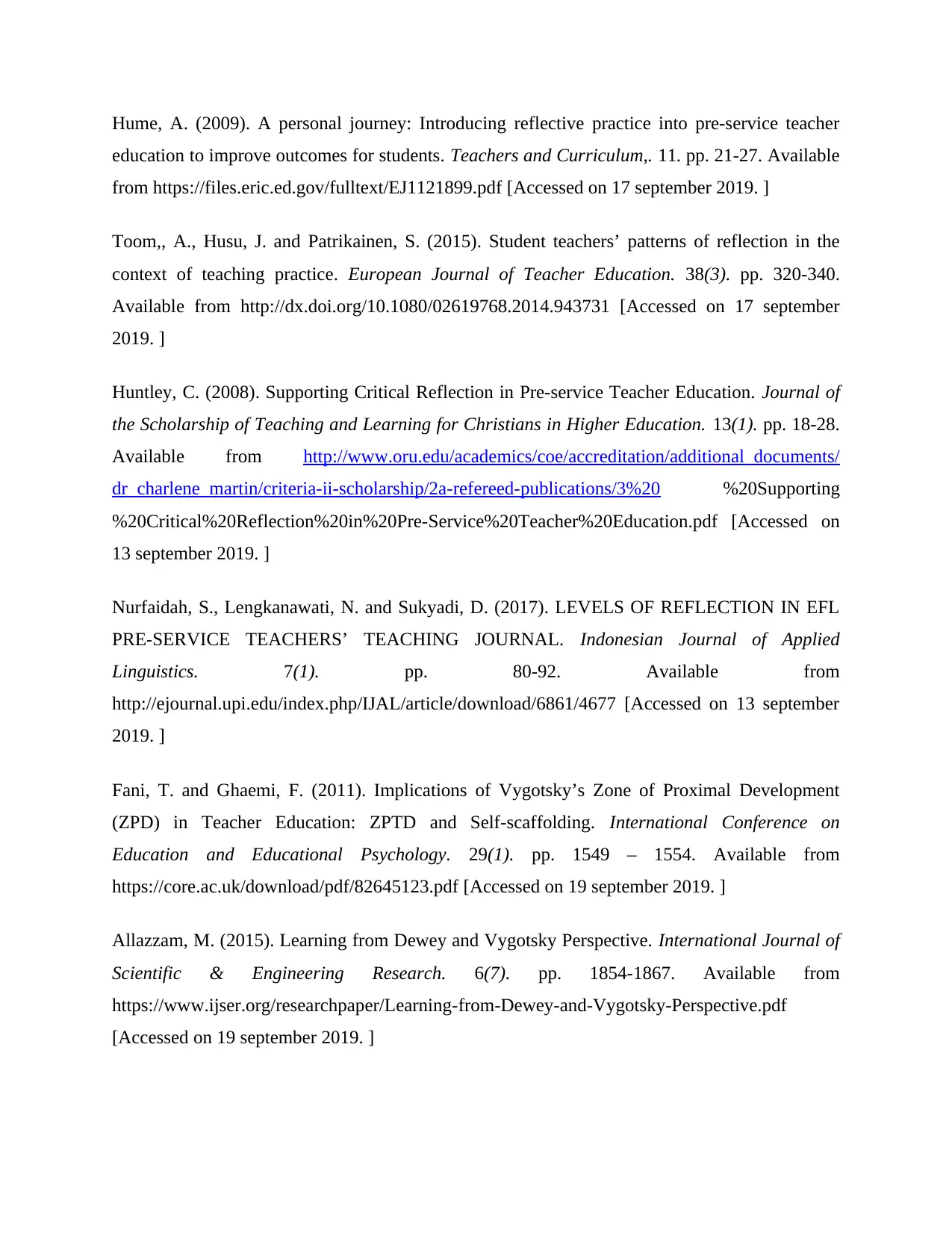
Hume, A. (2009). A personal journey: Introducing reflective practice into pre-service teacher
education to improve outcomes for students. Teachers and Curriculum,. 11. pp. 21-27. Available
from https://files.eric.ed.gov/fulltext/EJ1121899.pdf [Accessed on 17 september 2019. ]
Toom,, A., Husu, J. and Patrikainen, S. (2015). Student teachers’ patterns of reflection in the
context of teaching practice. European Journal of Teacher Education. 38(3). pp. 320-340.
Available from http://dx.doi.org/10.1080/02619768.2014.943731 [Accessed on 17 september
2019. ]
Huntley, C. (2008). Supporting Critical Reflection in Pre-service Teacher Education. Journal of
the Scholarship of Teaching and Learning for Christians in Higher Education. 13(1). pp. 18-28.
Available from http://www.oru.edu/academics/coe/accreditation/additional_documents/
dr_charlene_martin/criteria-ii-scholarship/2a-refereed-publications/3%20 %20Supporting
%20Critical%20Reflection%20in%20Pre-Service%20Teacher%20Education.pdf [Accessed on
13 september 2019. ]
Nurfaidah, S., Lengkanawati, N. and Sukyadi, D. (2017). LEVELS OF REFLECTION IN EFL
PRE-SERVICE TEACHERS’ TEACHING JOURNAL. Indonesian Journal of Applied
Linguistics. 7(1). pp. 80-92. Available from
http://ejournal.upi.edu/index.php/IJAL/article/download/6861/4677 [Accessed on 13 september
2019. ]
Fani, T. and Ghaemi, F. (2011). Implications of Vygotsky’s Zone of Proximal Development
(ZPD) in Teacher Education: ZPTD and Self-scaffolding. International Conference on
Education and Educational Psychology. 29(1). pp. 1549 – 1554. Available from
https://core.ac.uk/download/pdf/82645123.pdf [Accessed on 19 september 2019. ]
Allazzam, M. (2015). Learning from Dewey and Vygotsky Perspective. International Journal of
Scientific & Engineering Research. 6(7). pp. 1854-1867. Available from
https://www.ijser.org/researchpaper/Learning-from-Dewey-and-Vygotsky-Perspective.pdf
[Accessed on 19 september 2019. ]
education to improve outcomes for students. Teachers and Curriculum,. 11. pp. 21-27. Available
from https://files.eric.ed.gov/fulltext/EJ1121899.pdf [Accessed on 17 september 2019. ]
Toom,, A., Husu, J. and Patrikainen, S. (2015). Student teachers’ patterns of reflection in the
context of teaching practice. European Journal of Teacher Education. 38(3). pp. 320-340.
Available from http://dx.doi.org/10.1080/02619768.2014.943731 [Accessed on 17 september
2019. ]
Huntley, C. (2008). Supporting Critical Reflection in Pre-service Teacher Education. Journal of
the Scholarship of Teaching and Learning for Christians in Higher Education. 13(1). pp. 18-28.
Available from http://www.oru.edu/academics/coe/accreditation/additional_documents/
dr_charlene_martin/criteria-ii-scholarship/2a-refereed-publications/3%20 %20Supporting
%20Critical%20Reflection%20in%20Pre-Service%20Teacher%20Education.pdf [Accessed on
13 september 2019. ]
Nurfaidah, S., Lengkanawati, N. and Sukyadi, D. (2017). LEVELS OF REFLECTION IN EFL
PRE-SERVICE TEACHERS’ TEACHING JOURNAL. Indonesian Journal of Applied
Linguistics. 7(1). pp. 80-92. Available from
http://ejournal.upi.edu/index.php/IJAL/article/download/6861/4677 [Accessed on 13 september
2019. ]
Fani, T. and Ghaemi, F. (2011). Implications of Vygotsky’s Zone of Proximal Development
(ZPD) in Teacher Education: ZPTD and Self-scaffolding. International Conference on
Education and Educational Psychology. 29(1). pp. 1549 – 1554. Available from
https://core.ac.uk/download/pdf/82645123.pdf [Accessed on 19 september 2019. ]
Allazzam, M. (2015). Learning from Dewey and Vygotsky Perspective. International Journal of
Scientific & Engineering Research. 6(7). pp. 1854-1867. Available from
https://www.ijser.org/researchpaper/Learning-from-Dewey-and-Vygotsky-Perspective.pdf
[Accessed on 19 september 2019. ]
⊘ This is a preview!⊘
Do you want full access?
Subscribe today to unlock all pages.

Trusted by 1+ million students worldwide

Dervent, F. (2015). The effect of reflective thinking on the teaching practices of preservice
physical education teachers. Issues in Educational Research. 25(3). pp. 260-275. Available from
http://www.iier.org.au/iier25/dervent.pdf [Accessed on 13 september 2019. ]
Mansvelder-longayroux, D., Beijaard, D. and Verloop, N. (2007). The portfolio as a tool for
stimulating reflection by student teachers. Teaching and Teacher Education. 23.pp. 47–62.
Available from https://depts.washington.edu/comgrnd/ccli/papers/Mansvelder-
Longayroux_etal_PortfolioAsToolStimulatingReflectionByStudentTeachers-jy.pdf [Accessed on
13 september 2019. ]
Malatji, K. and Wadesango, N. (2014). Self-reflection as a Tool to Improve Teaching Practice:
The Practice and the Timing of Self-reflection by Primary Schools Teachers in the Mankweng
Circuit, Capricorn District. J Soc Sci. 41(3). pp. 375-383. Available from
http://www.krepublishers.com/02-Journals/JSS/JSS-41-0-000-14-Web/JSS-41-3-14-Abst-PDF/
JSS-41-3-375-14-1694-Wadesango-N/JSS-41-3-375-14-1694-Wadesango-N-Tx[8].pdf
[Accessed on 13 september 2019. ]
Marjeta, S. and Barbara, S. (2017). Critical reflection in the professional development of
teachers: challenges and possibilities. CEPS Journal. 7(3). pp. 67-85. Available from
https://www.pedocs.de/volltexte/2017/14908/pdf/cepsj_2017_3_Saric_Steh_Critical_reflection.p
df [Accessed on 13 september 2019. ]
physical education teachers. Issues in Educational Research. 25(3). pp. 260-275. Available from
http://www.iier.org.au/iier25/dervent.pdf [Accessed on 13 september 2019. ]
Mansvelder-longayroux, D., Beijaard, D. and Verloop, N. (2007). The portfolio as a tool for
stimulating reflection by student teachers. Teaching and Teacher Education. 23.pp. 47–62.
Available from https://depts.washington.edu/comgrnd/ccli/papers/Mansvelder-
Longayroux_etal_PortfolioAsToolStimulatingReflectionByStudentTeachers-jy.pdf [Accessed on
13 september 2019. ]
Malatji, K. and Wadesango, N. (2014). Self-reflection as a Tool to Improve Teaching Practice:
The Practice and the Timing of Self-reflection by Primary Schools Teachers in the Mankweng
Circuit, Capricorn District. J Soc Sci. 41(3). pp. 375-383. Available from
http://www.krepublishers.com/02-Journals/JSS/JSS-41-0-000-14-Web/JSS-41-3-14-Abst-PDF/
JSS-41-3-375-14-1694-Wadesango-N/JSS-41-3-375-14-1694-Wadesango-N-Tx[8].pdf
[Accessed on 13 september 2019. ]
Marjeta, S. and Barbara, S. (2017). Critical reflection in the professional development of
teachers: challenges and possibilities. CEPS Journal. 7(3). pp. 67-85. Available from
https://www.pedocs.de/volltexte/2017/14908/pdf/cepsj_2017_3_Saric_Steh_Critical_reflection.p
df [Accessed on 13 september 2019. ]
1 out of 10